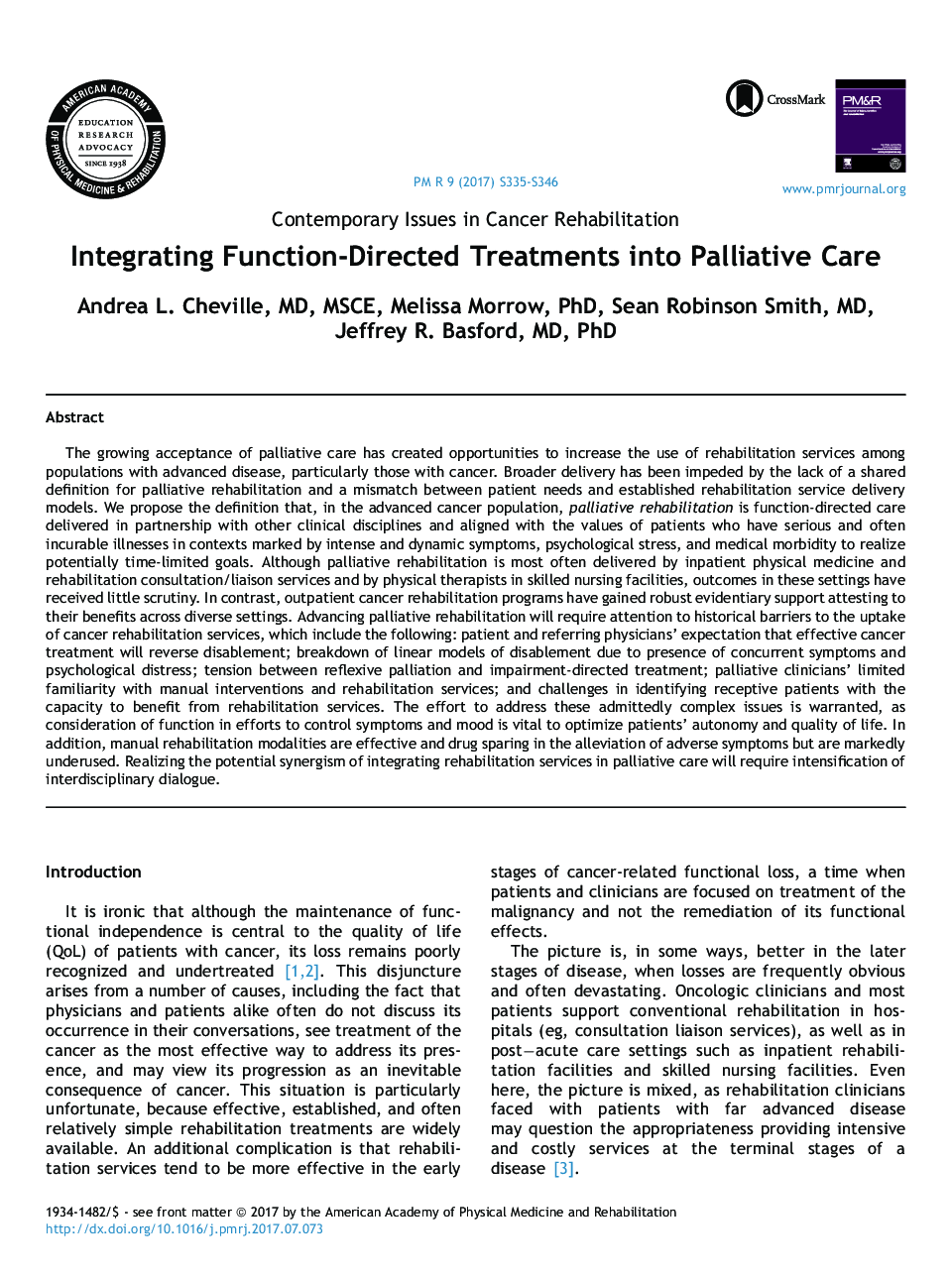| کد مقاله | کد نشریه | سال انتشار | مقاله انگلیسی | نسخه تمام متن |
|---|---|---|---|---|
| 5574938 | 1403952 | 2017 | 12 صفحه PDF | دانلود رایگان |
عنوان انگلیسی مقاله ISI
Integrating Function-Directed Treatments into Palliative Care
ترجمه فارسی عنوان
ادغام درمان های عملکردی به مراقبت تسکین دهنده
دانلود مقاله + سفارش ترجمه
دانلود مقاله ISI انگلیسی
رایگان برای ایرانیان
ترجمه چکیده
پذیرش در حال رشد از مراقبت های تسکین دهنده، فرصت هایی را برای افزایش استفاده از خدمات توانبخشی در میان جمعیت های مبتلا به بیماری های پیشرفته، به ویژه افراد مبتلا به سرطان ایجاد کرده است. تحویل گسترده تر به دلیل عدم تعریف مشترک برای توانبخشی ضعیف و عدم انطباق بین نیازهای بیمار و مدل های ارائه خدمات خدمات توانبخشی ایجاد شده است. ما این تعریف را پیشنهاد می کنیم که در جمعیت سرطان پیشرفته، توانبخشی تسکین دهنده، مراقبت های هدایت شده در همکاری با سایر رشته های بالینی است و با مقادیر بیماران مبتلا به بیماری های جدی و اغلب غیر قابل درمان در زمینه های نشانه های علائم شدید و پویایی، روانی استرس و بیماری های پزشکی برای دستیابی به اهداف بالقوه محدودیت زمانی. گرچه توانبخشی تسکین دهنده اغلب به وسیله خدمات فیزیوتراپی و خدمات توانبخشی بستری و خدمات ارتباطی و توسط متخصصان فیزیوتراپی در مراکز پرستاری ماهر انجام می شود، پیامدهای این تنظیمات کمی مورد توجه قرار گرفته است. در مقابل، برنامه های توانبخشی سرپایی سرپایی، شاهد حمایت قوی از مدارک اثبات شده برای منافع آنها در محیط های گوناگون است. پیشگیری از توانبخشی تسکین دهنده نیاز به توجه به موانع تاریخی در زمینه دریافت خدمات توانبخشی سرطانی دارد که شامل موارد زیر می باشند: انتظار بیمار و ارجاع پزشک که درمان موثر سرطان باعث از کار افتادگی می شود؛ تجزیه مدل های خطی از کار افتادگی به دلیل حضور علائم همزمان و اختلال روانی؛ تنش بین تسکین بازتابی و درمان مبتنی بر اختلال؛ آشنایی محدودی از پزشکان بالینی با مداخلات دستی و خدمات توانبخشی؛ و چالش ها در شناسایی بیماران پذیرفته شده با ظرفیت استفاده از خدمات توانبخشی. تلاش برای مقابله با این مسائل پیچیده قابل قبول ضروری است، زیرا توجه به عملکرد در تلاش برای کنترل علائم و خلق برای ارتقاء استقلال بیمار و کیفیت زندگی ضروری است. علاوه بر این، روشهای توانبخشی دستی موثر است و داروها در کاهش علائم نامطلوب، اما به شدت مورد استفاده قرار نگرفته اند. با درک همبستگی بالقوه از تلفیق خدمات توانبخشی در مراقبت تسکینی، نیاز به تشدید گفتمان میان رشته ای است.
موضوعات مرتبط
علوم پزشکی و سلامت
پزشکی و دندانپزشکی
ارتوپدی، پزشکی ورزشی و توانبخشی
چکیده انگلیسی
The growing acceptance of palliative care has created opportunities to increase the use of rehabilitation services among populations with advanced disease, particularly those with cancer. Broader delivery has been impeded by the lack of a shared definition for palliative rehabilitation and a mismatch between patient needs and established rehabilitation service delivery models. We propose the definition that, in the advanced cancer population, palliative rehabilitation is function-directed care delivered in partnership with other clinical disciplines and aligned with the values of patients who have serious and often incurable illnesses in contexts marked by intense and dynamic symptoms, psychological stress, and medical morbidity to realize potentially time-limited goals. Although palliative rehabilitation is most often delivered by inpatient physical medicine and rehabilitation consultation/liaison services and by physical therapists in skilled nursing facilities, outcomes in these settings have received little scrutiny. In contrast, outpatient cancer rehabilitation programs have gained robust evidentiary support attesting to their benefits across diverse settings. Advancing palliative rehabilitation will require attention to historical barriers to the uptake of cancer rehabilitation services, which include the following: patient and referring physicians' expectation that effective cancer treatment will reverse disablement; breakdown of linear models of disablement due to presence of concurrent symptoms and psychological distress; tension between reflexive palliation and impairment-directed treatment; palliative clinicians' limited familiarity with manual interventions and rehabilitation services; and challenges in identifying receptive patients with the capacity to benefit from rehabilitation services. The effort to address these admittedly complex issues is warranted, as consideration of function in efforts to control symptoms and mood is vital to optimize patients' autonomy and quality of life. In addition, manual rehabilitation modalities are effective and drug sparing in the alleviation of adverse symptoms but are markedly underused. Realizing the potential synergism of integrating rehabilitation services in palliative care will require intensification of interdisciplinary dialogue.
ناشر
Database: Elsevier - ScienceDirect (ساینس دایرکت)
Journal: PM&R - Volume 9, Issue 9, Supplement 2, September 2017, Pages S335-S346
Journal: PM&R - Volume 9, Issue 9, Supplement 2, September 2017, Pages S335-S346
نویسندگان
Andrea L. MD, MSCE, Melissa PhD, Sean Robinson MD, Jeffrey R. MD, PhD,
